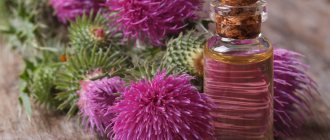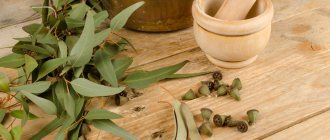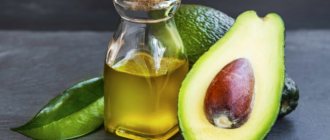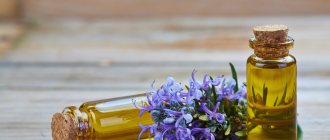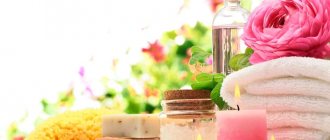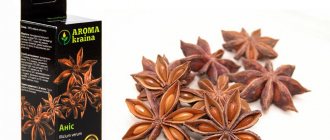One of the most popular and at the same time expensive base oils in cosmetology is jojoba oil. Strictly speaking, it is not exactly an oil, but rather a liquid wax that is obtained from the nuts of plants growing in the deserts of North America. The reputation of this oil is confirmed by more than a thousand years of history. It is completely unique in its chemical composition and beneficial properties, which are not lost even during long-term storage. Today we propose to talk about why and how to use jojoba oil, we will talk about its composition, dosages, and provide several beauty recipes using this component.
Main characteristics
In general, jojoba oil is extracted by cold pressing the nuts. During production, it retains absolutely all fatty acids, and due to the fact that it contains a huge amount of protein and vitamin E, jojoba moves from the category of ordinary base oils into a collection of the most effective antioxidants, agents that can quickly eliminate any inflammation.
One of the main characteristics of this oil is considered to be its high resistance to oxidation. This means that the aroma oil does not deteriorate and does not lose its unique properties over time, while being an ideal basis for dissolving any essential oils. Experts note: you can use jojoba oil in its pure form, but it is best to use it as a 10% solution, mixing it with other vegetable oils.
Jojoba is characterized by a light, almost imperceptible odor and a rich golden color. The oil changes its physical characteristics: at cold temperatures it hardens to the state of a waxy paste, and when warm it becomes relatively liquid. Cosmetologists note: jojoba is the only base oil that does not leave behind a greasy shine on either the skin or hair. At the same time, it is able to form a dense protective layer.
Description and chemical composition of jojoba oil
The product is made from the fruits of the Simmondsia sinensis plant. Its habitat is North America (California and Arizona), Argentina, Mexico, Israel. The product has been used for at least 3 thousand years. However, the industrial production of jojoba oil, which has medicinal properties, began in the 70s of the 20th century.
The shrub of Simmondsia chinensis reaches a height of 1-2 m
The healing properties and uses of jojoba essential oil are due to its rich composition:
- tocopherols;
- wax esters;
- higher fatty acids (palmitic, behenic, nervonic, palmitoleic, oleic, erucic, gadoleic);
- ceramides;
- collagen;
- alcohols (eicosene, tetracosene).
What does jojoba oil smell like and color?
Liquid wax has a neutral or faint odor of fat. The product has a transparent and oily consistency, with a golden hue.
Jojoba oil: composition
You can purchase this product at any pharmacies and cosmetic stores. In addition, you can also find granules of jojoba wax on the shelves, which were prepared by hydrogenation. You can add such granules to homemade cosmetics. The study of the composition and properties of jojoba began in the seventies of the last century. Researchers were able to find out that this oil is quite close in its biochemical composition to spermaceti. This is the name of a unique substance that was previously extracted from the frontal part of the head of sperm whales.
The main components of jojoba oil include fatty acids and their esters, amino acids, collagen, vitamin E, and carotenoids. Let us note that this composition is truly unique: it does not replicate any of the known vegetable oils. In addition to the fact that this composition has beneficial properties for the skin, it provides the oil with high stability: jojoba is not afraid of exposure to sunlight, oxidation and heat. Moreover, the oil can be stored for a long time even without the use of any additives. For this reason, it is often used as a preservative in the manufacture of cosmetics.
A Brief History of Jojoba Oil
Simmondsia sinensis was completely mistakenly named this way, and in fact does not grow in the territory of Cathay, but in desert areas. The plant grows in the deserts of southern North America, and the oil obtained from the fruit has been known to mankind for at least three millennia.
According to archaeological excavations carried out in Egypt, the product was known to the pharaohs because it was found in tombs, and industrial production began only in the 70s of the last century.
Use in cosmetology
The use of jojoba oil, according to cosmetologists, is almost limitless: it is an ideal component for basic and specialized skin care not only for the face, but also for the décolleté and neck. The product moisturizes and nourishes the skin, restores damage, relieves irritation, redness and inflammation. Jojoba is even suitable for caring for delicate skin around the eyes that requires special attention; it can be used in the manufacture of various vitamin applications and patches. Jojoba oil is also an excellent base for masks. The product has proven effective in treating chapped skin, including on the lips; it quickly eliminates rashes and cracking.
Cosmetologists note: the oil has anti-inflammatory properties, can stimulate the regeneration of skin cells, quickly heals cracks, injuries, cuts, dermatitis and irritation. Moreover, it can also be used in the fight against cellulite and to eliminate stretch marks. One more advantage of jojoba oil for the body, hands, and face should be noted: it is suitable for absolutely any skin type, and can be used by those with oily, normal, dry, problem skin - regardless of age.
Other positive properties of oil in cosmetology include protective, rejuvenating and cleansing. In addition, it can be used even by women who often experience allergic reactions to any skin care cosmetics.
Jojoba oil - beneficial properties and uses
What are the benefits of jojoba oil? – it has a unique chemical composition. The oil obtained from the fruits of this plant is quickly and well absorbed, easily penetrates the skin, nourishing it with biologically useful substances and vitamin E. Jojoba fruits have a regenerating, antioxidant, antiseptic and anti-inflammatory effect.
These beneficial properties of the oil are widely used in the pharmaceutical and cosmetic industries.
In folk medicine, it is used to treat skin diseases (eczema, dermatitis, psoriasis) and is included in homemade mask recipes for skin and hair care.
How is jojoba oil obtained?
Simmondsia fruits are used to make oil
Jojoba oil is obtained from nuts grown on plantations in Argentina, Israel, California, Arizona, and Northern Mexico by cold pressing. The cake from oil production contains a large amount of protein, which made it possible to add it to animal feed. It is impossible to prepare the oil yourself; it can only be purchased in finished form.
Where to buy and how to choose quality oil
You can purchase oil in online stores, pharmacies or specialized cosmetic departments of large supermarkets. When purchasing, in order to avoid counterfeits, you should study the composition on the label (the name of the plant should be indicated in Latin), pay attention to the color, and, if possible, the smell. You need to choose jojoba oil from trusted manufacturers and sellers. It should be understood that natural oil is not a cheap product.
the cost of natural oil without additives can reach up to 1000 rubles per 100 ml.
How to store oil at home
At home, jojoba oil should be stored in a glass container, in a place protected from sunlight. It is better to use the refrigerator for storage; it will have a thick consistency and will preserve all the useful substances.
Physical and chemical properties of oil
Jojoba oil is a universal and unique healing agent
The chemical composition of the oil is unique. It contains monounsaturated liquid esters, tocopherols, fatty acids (oleic, docosenoic, eicosonic), amino acids, wax, large amounts of vitamin E. Jojoba oil contains alcohols (decosahexoene, tetracosene, eicosene), minerals (copper, silicon, zinc, chromium).
The consistency of the oil in a warm place is liquid, in a cold place it is thick, waxy. Natural unrefined oil has a golden color with a slightly oily odor. The oil melts at 10C and has a high oxidation index, which allows it to maintain quality for a long time. Has high resistance to thermal effects and oxidation.
Advantages and disadvantages of oil
Benefits: The benefits of jojoba oil lie in its chemical composition - its unique acid and fat balance is not repeated in any other natural oil. Gadoleic acid is the main component of the wax, reaching 80%, which prevents skin aging and is called the “elixir of youth.”
The oil is actively used in cosmetology; various masks are prepared on its basis to gently care for the skin.
Cosmetic oil has the following beneficial properties and uses in cosmetology:
- effectively removes swelling, redness and inflammation of the skin;
- creates a protective barrier without blocking the normal functioning of hair and skin;
- retains natural moisture without leaving greasy marks;
- protects skin and hair from adverse environmental factors, chemical and physical effects;
- has a restorative effect on the structure of skin and hair;
- has cleansing properties and normalizes the function of hair follicles;
- has a nourishing and satiating effect.
Harm and contraindications: the disadvantages of the oil include the high cost of the product and dosed intake - you cannot use more than 6 drops per day, otherwise an oily sheen will appear on the skin. You can use the oil without fear - the product is not an allergen, but in rare cases, a rash and irritation may appear on the skin.
Use with caution for women who have increased growth of facial hair, since the oil is a growth activator, which in this case is undesirable.
Dosage Features
Using jojoba oil is not difficult: in order to enrich the cream or lotion, you need to add 15% of this oil to the finished composition. Jojoba oil for the face - in its pure form, mixed with other base oils - can be used for daily skin care after cleansing. If you want to prepare a nutritious mixture, combine jojoba, olive, apricot kernel and avocado oils in equal parts; for every two tablespoons of this mixture you will need one drop of lemon or orange essential oil.
If your skin is prone to flaking, you can use a tablespoon of jojoba oil with two drops of lavender. For aging skin, instead of lavender, patchouli oil is suitable, and tea tree oil can cope with the problems of skin prone to rashes. In order to obtain a suitable composition for the delicate skin around the eyes, you can add a drop of fennel or mint oil to jojoba oil. To care for lips with jojoba, it is better to combine lemon balm.
Using jojoba oil, you can prepare a unique smoothing mixture that can eliminate stretch marks: you need to combine jojoba, avocado, lavender, orange, mint and rosemary.
To care for your hair, you can add about 5 drops of jojoba oil to your shampoo or conditioner. At the same time, if it is important to solve the problem of hair loss, it is recommended to add sage and eucalyptus oil. A combination of jojoba, ylang-ylang and orange will help with dry hair; this composition must be applied to a wooden comb, which you use to comb your hair after washing. What else is jojoba oil good for? Experts talk about the effectiveness of massages, applications and compresses for various skin lesions.
Jojoba oil in cosmetology
Jojoba seed oil is more often used in cosmetology than in medicine. It is a popular product and is suitable both for daily care and for combating emerging skin problems. Jojoba oil can also be added to any purchased cosmetic product to enrich the composition.
Jojoba oil is an ideal product for cosmetic procedures.
For face
In its pure form, jojoba oil is used for facial skin only in certain cases:
- in small areas when damage or peeling appears;
- as a face mask, which should be washed off with warm water after 20 minutes;
- to reduce wrinkles, into which oil should be driven;
- to improve the properties of cosmetics.
Do not use undiluted product around the eye area. It is better to mix jojoba oil with any other oil in a ratio of 1:4.
Jojoba wax is used daily to prevent skin irritation after shaving, as well as after water procedures to soften rough epidermis. Add a couple of drops of orange oil to one tablespoon of the product and rub into the desired areas.
Orange essential oil is used to nourish and moisturize facial skin.
For aging or tired skin, you can make a mask by mixing one tablespoon of the main product and one drop of patchouli oil. And if instead of the latter you add tea tree ether, then this mixture will help fight inflammation on the face. Apply the composition only to problem areas.
Rubbing a mixture of one tablespoon of jojoba oil and two drops of lemon balm ether will help make your lips soft and get rid of flaking. The product should be used morning and evening.
Video: jojoba oil to improve skin condition
For hair
To restore thin, dry and brittle hair, it is recommended to comb your hair with a comb two to three times a week, after adding a mixture of one teaspoon of jojoba oil and five drops of ylang-ylang ether.
Using jojoba will restore beauty to your hair, accelerate its growth, prevent hair loss and dandruff.
A few drops of the product can be added to any shampoo, conditioner and conditioner and used as usual. In addition, rubbing jojoba oil into the hair roots 10-15 minutes before washing your hair is very beneficial.
Those who constantly style their hair using a hair dryer, curling iron or straightener constantly have to deal with hair frizz and split ends. An excellent thermal protection would be to apply a couple of drops of jojoba oil to damp strands.
For body, nails and hands
You can fight stretch marks by rubbing two tablespoons of jojoba oil and two drops of orange ether into the desired areas. With the same mixture you can do anti-cellulite massage of problem areas. The elasticity of the skin will be restored by lubricating it with a composition of jojoba and rosemary oils in proportions 1:2.
Rosemary essential oil improves the overall condition of the skin, smoothing and softening it
If your nails do not receive enough nutrition and hydration, they break and peel. Cracks often form on the nail plate. Jojoba oil will help cope with such problems. Rubbing it in is also used to soften and moisturize the cuticle. After several procedures it will increase more slowly.
For weight loss
Jojoba seeds contain substances that help reduce appetite. Amino acids and vitamins improve the functioning of the gastrointestinal tract. With regular use of the product, weight loss occurs. Before each meal, take one tablespoon of oil with a glass of water. Before you start using this method, you should definitely consult your doctor.
Oil damage
Speaking about the use of this amazing oil, it should be noted that individual intolerance to it is a rather rare phenomenon. However, before the first use, it is recommended to carry out a test: one drop of oil should be rubbed into the wrist. After half an hour, you should evaluate the condition of the skin: if redness appears, it is better to stop using the oil. If you decide to use jojoba oil daily all over your facial skin (especially if it is oily), you may trigger active sebaceous gland activity. The result is numerous inflammations.
Composition and beneficial properties of jojoba
- Fatty acids - gadoleic, docosenoic, oleic, eicosenoic, stearic, palmitoleic and others - protect hair from external aggressive influences, nourishing and moisturizing it.
- Alcohols - docosahexoene, eicosene, tetracosene - accelerate blood circulation in the area of hair follicles and normalize sebum production.
- Collagen compacts the scales of the keratin shaft of the hair, smoothing out their structure.
- Tocopherol has a rejuvenating effect.
Jojoba also contains tannins, mineral salts, vitamins E and C and other useful components for which natural vegetable oils are so valued.
In most cases, the product is used as a base product, which is combined with various types of activators. They enhance the effect of beneficial substances, helping them penetrate into the deeper layers of the skin.
Jojoba oil is used to restore damaged and split ends of hair, moisturizes strands, relieves curls of unpleasant greasy shine, restores their damage and activates protective functions. The versatility of the tool lies in the fact that it independently recognizes in which area it needs to act.
Therefore, the scope of application of this hair oil is so wide: alopecia, combating seborrhea, restoration of split ends, and activation of growth.
How to choose quality oil
High-quality oil is usually sold in small bottles made of dark glass. The list of main producing countries includes the United States of America, Australia, Mexico, Egypt, Brazil, Argentina, Peru and Israel. It should be noted that in cold climatic conditions this plant is simply not able to survive, and therefore it is enough to look at the specified country to recognize a fake. It is best to store this oil in the refrigerator; before use, you need to heat only the amount that is needed to prepare the cosmetic product. This can be done either at room temperature or using a water bath. By the way, unlike other vegetable oils, this can be stored for several years - due to the fact that it contains a large amount of ceramides, which do not allow it to oxidize.
Jojoba essential oil and its composition
Thanks to the proteins and amino acids contained in jojoba essential oil, fatty acids, fatty acid esters, collagen, vitamin E and other nutrients, it has pronounced anti-inflammatory, regenerating and antioxidant properties. If you carefully study the fatty acid composition of jojoba essential oil, the main acids will be the following: eicosenoic, docosahexaenoic and oleic, which are also found in other oils, for example, sandalwood oil, but jojoba essential oil does not contain triglycerides.
Separately, it is necessary to say about long-chain rare fatty acids, which help improve the composition of the essential oil and are not found in other known essential oils
.
Jojoba oil
Due to its chemical composition, jojoba essential oil remains in a liquid aggregate state at room temperature. When exposed to sub-zero temperatures, the oil of this plant hardens, which does not affect its properties. Once heated, the oil is ready for use again.
Thanks to substances with preservative properties, it can be stored for a long time, and even after some time it will not taste bitter like other essential oils. In addition, if the mixture of essential oils includes jojoba essential oil, then it can also be stored for a long time without losing its properties. As proof, let us recall the well-known fact that in the excavations of the tombs of Egyptian kings, jojoba essential oil was found, which fully retained its nutritional properties and quality.
The consistency of this oil is thicker than other essential oils, for example, flax essential oil, but this does not prevent it from penetrating deeply into the hair and skin, creating a protective layer without a greasy sheen, which is typical of other oils with a less thick consistency.
Jojoba cosmetic oil
The presence of jojoba oil in cosmetics and care products gives them softening, moisturizing properties, and increases resistance to temperature changes and oxidation. If you look closely at the structure of this essential oil, it will become clear that it is more like liquid wax than an oil similar to spermaceti, although this does not prevent it from being used for:
- dermatitis and psoriasis;
- eczema and neurodermatitis;
- joint inflammation;
- redness and other skin inflammations;
- as a care product for the delicate skin of babies;
- skin problems after taking a bath, after shaving;
- uneven skin tan. It levels it out and makes it uniform;
- problems with the skin of the lips, hair of any type, etc.
Rapid penetration through the skin barrier is due to the similarity of jojoba oil and wax esters, which make up 25% of the sebum that makes up our skin.
Application for face
This unique oil is widely used in the field of facial skin care. Its delicate texture allows it to be quickly absorbed, without leaving any greasy shine or unpleasant sticky film. The product does not clog pores, allows the skin to breathe freely and maintains its natural moisture level. You can use oil-wax for all areas of the face.
The product increases elasticity and firmness, makes the skin smooth and soft. Jojoba oil is widely used for the face against wrinkles, post-acne, dull skin color, swelling and acne. Some women use jojoba as a sunscreen if their skin is sensitive to ultraviolet light. You can apply it before tanning: powerful natural filters will not allow the skin to burn or redden, and the fabrics will not lose moisture in the sun. It is also recommended to use jojoba oil in the cold season: it will protect against hypothermia, chapping, and prevent flaking of the skin.
For body
Cosmetologists recommend using jojoba oil for the entire body: this will maintain a normal level of moisture and elasticity of the skin, make it tightened, and eliminate stretch marks. Regular application of the product to the neck, décolleté, and arms will help you look young and attractive longer. It should be noted that jojoba oil does an excellent job of removing rough tissue on the knees, palms, feet and elbows. It can also be used for cellulite changes in the skin, both for existing problems and as a preventive measure.
For curls
When talking about what jojoba oil can be used for, we cannot fail to mention hair. Wax from seeds nourishes and moisturizes curls from roots to ends, restores structure, solving the problem of dandruff, normalizing the functioning of the sebaceous glands. Indications for wax use include the following:
- dry hair;
- lack of volume;
- dandruff;
- slow hair growth or loss;
- increased greasiness;
- damage due to chemical perms, bleaching, frequent use of straightening irons, hair dryers and curling irons.
For eyelashes
Do your eyelashes fall out, break or grow poorly? Jojoba oil, used in its pure form, works real miracles. It should be applied along the edges of the eyelids, thereby nourishing the follicles and strengthening the eyelashes. In addition, this allows you to awaken the bulbs, which are currently in the sleep phase. This significantly increases the volume of eyelashes, they become darker, longer, and the look becomes more expressive. You can use jojoba oil to remove eye makeup.
How is jojoba oil obtained?
Jojoba oil is actually not an oil, but a special liquid wax (according to other sources, an ether). This substance is obtained from the seeds of a South American shrub with the exotic name “Simmondsia sinensis” (yes, the discrepancy between the homeland of the plant and its name is another strange discrepancy, which, however, does not detract from its beneficial properties).
In aromatherapy, jojoba oil is classified as a base oil. This means that it can be used both in its pure form and as a base for mixing more active oils - for example, essential or wheat germ. As an ingredient, it is actively used in the manufacture of moisturizing skin creams and hair products.
Use undiluted
Why is jojoba oil used in its pure form? Cosmetologists say: this product should be applied to those areas where the skin is especially dry, dense or rough, for example, on the elbows, knees, lips or heels. It is recommended to repeat the procedure only a couple of times a week. You should be especially careful when using pure oil on your face: this can eliminate deep wrinkles, but too frequent use of wax can clog the cells. The best way to use pure oil is as a mask or application. It is enough to apply the product to the skin with a brush or soak a cloth with it. After fifteen minutes, it is recommended to rinse off the product with warm water.
Harm, contraindications
Even the safest cosmetic product, if used frequently, can cause disruption of the lipid layer, thinning, and premature aging instead of the expected rejuvenation effect. For this reason, even though this product is a wax in its chemical structure, it should not be used in its pure form or as part of masks more than once a week.
Contraindications for use are the presence of:
- individual intolerance;
- severe burns;
- open wounds;
- skin diseases.
If there are skin diseases, use on the affected areas is possible only after consulting a dermatologist.
For wrinkles
Thinking about using jojoba oil on your face for wrinkles? You will need the following ingredients:
- one chicken yolk;
- a teaspoon of fat sour cream or cream;
- a tablespoon of jojoba oil;
- a teaspoon of liquid honey.
Preparation of the product is quite simple: you need to heat the honey and oil in a water bath, add the remaining ingredients, apply the product to the skin and leave for 20 minutes. After the specified time, it is recommended to wash off the mask with warm water.
Anti-aging masks
Many women use jojoba oil for wrinkles. To do this, two teaspoons of this product are mixed with a small piece of melted beeswax and one chicken yolk. The resulting mask is applied to a previously cleansed face and left for fifteen or twenty minutes. After the specified time has passed, it is washed off with warm water.
No less effective in combating age-related changes is a product made from a tablespoon of jojoba oil and beaten egg yolk. Add 1 tsp to the resulting mixture. cream and liquid honey. All this is applied to a cleansed face, and after twenty minutes it is washed off with warm water.
To speed up regeneration and increase skin elasticity, you can use another proven remedy. To prepare it, combine two teaspoons of full-fat cottage cheese and an egg yolk in one bowl. All this is thoroughly rubbed and then mixed with an ampoule of retinol. Finally, add eight drops of jojoba oil extract. The resulting mask is applied to the facial skin with massage movements and kept for twenty minutes. Then it is washed off with warm water. This procedure must be repeated at least three times a week. And the entire course lasts twenty-one days.
Article on the topic: Oriental hyacinth - beneficial properties, description
Another homemade cosmetic product has a good tightening effect. To prepare it, washed and peeled peaches are processed using a blender. A teaspoon of buckwheat flour, eight drops of jojoba and three milliliters of grape seed oil are added to the resulting puree. Mix everything thoroughly and apply it to pre-steamed facial skin with gentle movements. After half an hour, wash off the mask with warm water. In the cold season, persimmons can be used instead of peaches.
For acne and oily skin
Worried about acne, oily and greasy skin? Try making a composition with the following ingredients:
- one tablespoon each of jojoba oil and white or blue clay;
- some warm water;
- half a tablespoon of calendula tincture;
- a couple drops of lavender essential oil.
Preparing the product is quite simple: you need to dilute the clay in warm water and add the remaining ingredients to it, mix well. The resulting mask should be applied to the skin. After the mixture dries, it should be washed off with warm water. After this, it is recommended to apply any moisturizer to the skin.
Use at home
In addition to using jojoba oil in professional cosmetology, it is also actively used at home. There is a wide variety of care products based on this substance. In addition, preparing them yourself is much more affordable financially.
The most popular and effective masks are:
- From wrinkles. To prepare it you will need 1/3 tsp. butter and natural honey, as well as 1 tsp. yogurt and cosmetic clay. Add egg white to this mass, after which it can be applied to the skin of the face and neck. After 10 minutes, rinse with warm water. The skin is perfectly toned and becomes more elastic.
- From stretch marks. To 1 tablespoon of oil add 2 drops each of geranium, clove and rosemary oils. It is recommended to apply the resulting mixture to problem areas. This procedure eliminates sagging, increases firmness and elasticity.
- For hair growth. Take 2 tablespoons of jojoba oil and burdock oil, as well as 5 drops of vitamin E. Rub this mixture thoroughly into the hair roots, leaving on the surface for up to 30 minutes, after which you can rinse.
- To strengthen nails. Combine the main component in equal proportions with olive and almond oil, and also add vitamin A and E to them. This product perfectly restores the nail plate, making nails beautiful and healthy.
- For eyelashes. Take 1 tsp. jojoba oil and add to it 1 drop each of jasmine, nutmeg and sandalwood oils. Apply the composition with light movements to the surface of the eyelashes and eyebrows, and after 10 minutes rinse with water.
And now a video - a recipe for a hair mask using jojoba oil.
Jojoba oil itself is one of the most hypoallergenic. Individual intolerance occurs extremely rarely. However, if you are using it for the first time, it is better to do a test: apply one drop to your wrist, evaluate the condition of the skin after half an hour.
It is so safe that cosmetologists and doctors recommend that breastfeeding women apply it to their nipples in between feedings to quickly heal cracks.
Jojoba oil has no contraindications, except in cases of individual intolerance.
For hair
What is jojoba oil used for hair? It allows you to solve problems such as damage and dryness, brittle hair, and slow growth. To prepare the mask you will need:
- a tablespoon of melted honey;
- 1 egg yolk;
- two tablespoons of jojoba wax;
- a couple of drops of sandalwood or neroli essential oil.
The main component of the product – jojoba – needs to be heated and the rest of the mask components added to it. The composition must be applied to the root part, and only then distributed over the entire length of the hair. It is recommended to warm the mask, keep it on your hair for 30-40 minutes, then rinse thoroughly with shampoo.
Jojoba oil is also suitable for oily hair. To do this, 1 tablespoon of the product must be mixed with two tablespoons of lemon juice and the pulp of one avocado. The composition must be applied to damp hair, rubbed in, and rinsed off after an hour.
For dry and sensitive skin
When talking about using jojoba oil for the eyes or for sensitive facial skin, cosmetologists recommend preparing a nourishing and moisturizing product from the following components:
- a tablespoon of jojoba oil and full-fat cottage cheese;
- a teaspoon of freshly squeezed carrot juice.
Preparation will only take a few minutes: the oil must be heated in a water bath, mix the juice and cottage cheese in a separate bowl, add warm oil and apply to the face for 15 minutes. After this, the remnants of the mask should be removed with a soft cloth and washed with warm water.
For hands
The skin of the hands is daily exposed to the adverse effects of temperature changes, ultraviolet radiation, comes into contact with hard water, household chemicals, and therefore needs daily protection, moisturizing and nutrition. Jojoba oil will help cope with this task. You can prepare various care products for your hands. We offer a composition that is suitable for daily use. The list of components is simple:
- ¼ part of a glass of jojoba oil, the same amount of emulsion wax;
- 50 ml water;
- 10-15 drops each of patchouli and incense oils.
In order to prepare such a homemade cream, it is recommended to combine wax and oil, heat them in a water bath and mix, then add essential oil, heat the water in a separate container to 40-50 degrees, and add to the composition. After this, all components must be thoroughly mixed again, poured into a glass jar and left in the refrigerator. The product can only be applied to clean hands.

